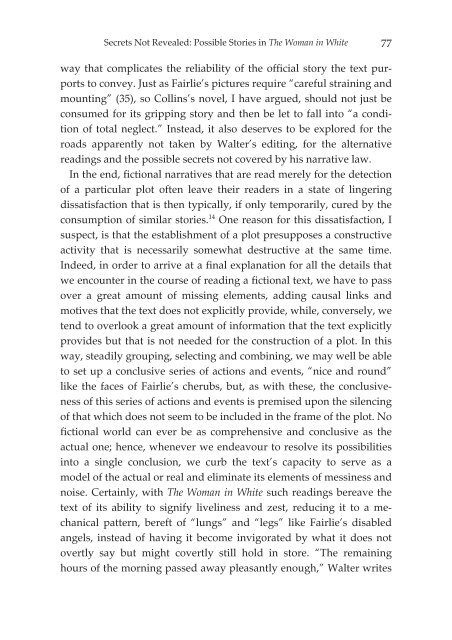Connotations 18.1-3 (2008/2009)
Connotations 18.1-3 (2008/2009)
Connotations 18.1-3 (2008/2009)
Create successful ePaper yourself
Turn your PDF publications into a flip-book with our unique Google optimized e-Paper software.
Secrets Not Revealed: Possible Stories in The Woman in White<br />
way that complicates the reliability of the official story the text purports<br />
to convey. Just as Fairlie’s pictures require “careful straining and<br />
mounting” (35), so Collins’s novel, I have argued, should not just be<br />
consumed for its gripping story and then be let to fall into “a condition<br />
of total neglect.” Instead, it also deserves to be explored for the<br />
roads apparently not taken by Walter’s editing, for the alternative<br />
readings and the possible secrets not covered by his narrative law.<br />
In the end, fictional narratives that are read merely for the detection<br />
of a particular plot often leave their readers in a state of lingering<br />
dissatisfaction that is then typically, if only temporarily, cured by the<br />
consumption of similar stories. 14 One reason for this dissatisfaction, I<br />
suspect, is that the establishment of a plot presupposes a constructive<br />
activity that is necessarily somewhat destructive at the same time.<br />
Indeed, in order to arrive at a final explanation for all the details that<br />
we encounter in the course of reading a fictional text, we have to pass<br />
over a great amount of missing elements, adding causal links and<br />
motives that the text does not explicitly provide, while, conversely, we<br />
tend to overlook a great amount of information that the text explicitly<br />
provides but that is not needed for the construction of a plot. In this<br />
way, steadily grouping, selecting and combining, we may well be able<br />
to set up a conclusive series of actions and events, “nice and round”<br />
like the faces of Fairlie’s cherubs, but, as with these, the conclusiveness<br />
of this series of actions and events is premised upon the silencing<br />
of that which does not seem to be included in the frame of the plot. No<br />
fictional world can ever be as comprehensive and conclusive as the<br />
actual one; hence, whenever we endeavour to resolve its possibilities<br />
into a single conclusion, we curb the text’s capacity to serve as a<br />
model of the actual or real and eliminate its elements of messiness and<br />
noise. Certainly, with The Woman in White such readings bereave the<br />
text of its ability to signify liveliness and zest, reducing it to a mechanical<br />
pattern, bereft of “lungs” and “legs” like Fairlie’s disabled<br />
angels, instead of having it become invigorated by what it does not<br />
overtly say but might covertly still hold in store. “The remaining<br />
hours of the morning passed away pleasantly enough,” Walter writes<br />
77

















